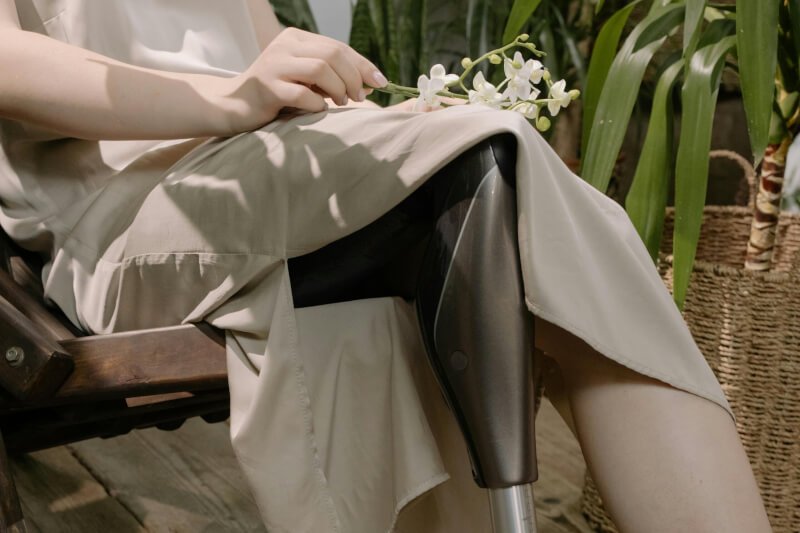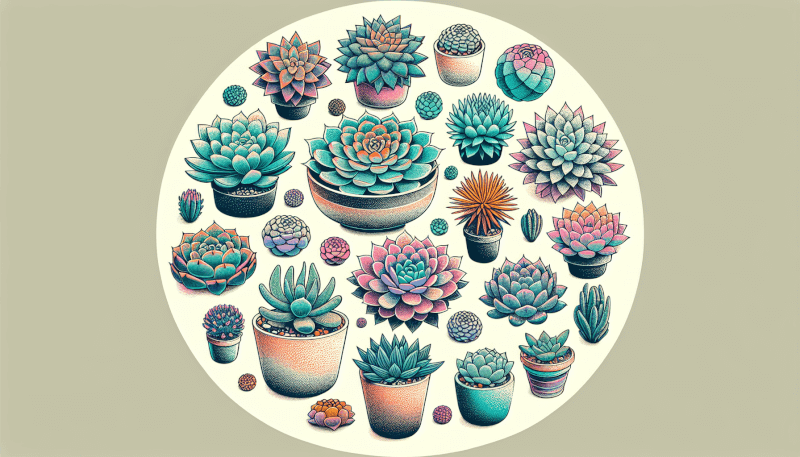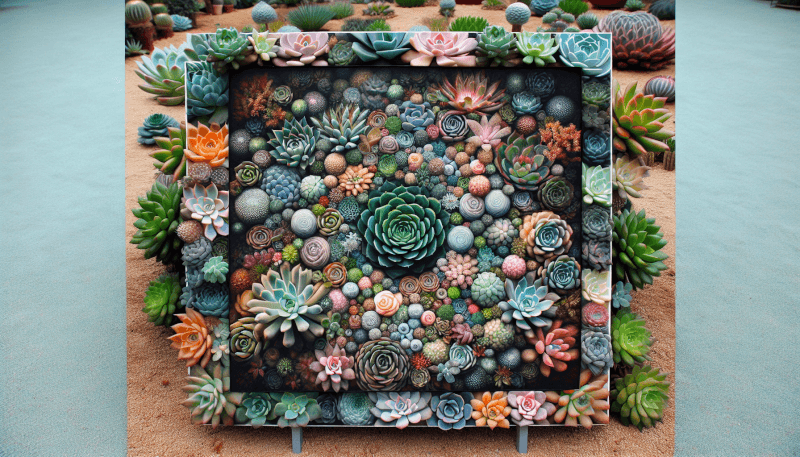So you’ve decided to create your own DIY succulent garden and you’re looking for the best ways to design it. Succulent gardens are not only a beautiful addition to any space, but they are also low maintenance and perfect for those who may not have a green thumb. In this article, we will explore some creative and easy ways to design your own succulent garden that will leave your friends and family impressed. Whether you’re a beginner or an experienced gardener, these tips and ideas will help you create a stunning and thriving succulent garden that you can be proud of.

Selecting the Right Succulent Plants
Choosing the right succulent plants is crucial for the success of your DIY succulent garden. Before you start, it’s important to research different types of succulents to find the ones that will thrive in your specific climate and growing conditions. Some succulents prefer dry and arid environments, while others do well in more temperate climates. By understanding the different types and their needs, you can create a garden that will flourish.
Consider the growth habit and size of the succulent plants you choose. Some succulents grow tall and upright, while others stay low and spread out. Think about how you want your garden to look and consider the available space. If you want a compact and tidy garden, select succulents that will stay small. If you prefer a more lush and wild look, choose taller and more sprawling varieties.
It’s also important to choose succulent plants with similar watering needs. Some succulents require more frequent watering, while others can go longer periods without water. By selecting plants with similar watering needs, you can ensure that all your succulents are happy and healthy. This will make it easier for you to maintain a consistent watering schedule and avoid over or under-watering.
Deciding on the Location and Size of Your Garden
When deciding on the location for your DIY succulent garden, consider the amount of sunlight the area receives. Most succulents thrive in bright, indirect sunlight, so choose a spot that gets at least 6 hours of sunlight per day. If you have limited sunlight, consider placing your garden near a window or using grow lights to supplement natural light.
Evaluate the available space for your garden. Keep in mind that succulents need room to grow and expand. Make sure the area you choose allows for adequate air circulation and doesn’t feel cramped. If you have a small space, consider creating a vertical garden or using hanging planters to maximize the use of space.
Create a layout and plan for expansion. Before planting your succulents, sketch out a rough layout of where each plant will go. This will help you visualize how the garden will look and ensure that you have enough space for each plant. Additionally, consider the potential for future expansion. Succulents are known for their ability to propagate easily, so you may want to leave room for new plants in the future.

Preparing the Soil and Containers
Succulents require well-draining soil to prevent root rot. Use a specialized succulent or cactus potting mix, or create your own by mixing regular potting soil with sand or perlite. This will ensure that excess water can drain away quickly, keeping the roots healthy.
Adding organic matter and grit to the soil can improve its drainage and nutrient content. Incorporate compost or well-rotted manure to enrich the soil and provide essential nutrients for your succulents. Gritty materials like crushed gravel or pumice can be added to further improve drainage and prevent soil compaction.
Select suitable containers for your succulent garden. Choose containers with drainage holes to allow excess water to escape. Terra cotta pots are a popular choice for succulents as they are porous and allow for better airflow. However, you can also use ceramic or plastic containers as long as they have drainage holes. Remember to choose containers that are the appropriate size for your succulents, allowing enough room for growth.
Arranging and Designing the Layout
When arranging your succulent garden, start by deciding on the overall design style you want to achieve. Do you prefer a minimalist garden with clean lines and simple arrangements, or a more whimsical and eclectic look? Think about the aesthetic you want to create and choose plants and containers that align with that style.
Consider color, texture, and shape when selecting succulents for your garden. Succulents come in a wide variety of colors, from deep greens to vibrant purples and oranges. Mixing different hues can create a visually stunning garden. Additionally, pay attention to the texture of the plants. Some succulents have smooth leaves, while others have intricate patterns or fuzzy textures. Combining different textures can add depth and interest to your garden.
Group plants with similar characteristics together to create visual cohesion. Cluster succulents with similar colors, shapes, or sizes to create a sense of harmony in your garden. This will give the illusion of a well-planned and intentional design.

Creating Focal Points and Visual Interest
Incorporate tall and vertical plants to create focal points in your succulent garden. Taller succulents like Echeveria ‘Black Prince’ or Agave americana can add height and drama to your garden. Place them strategically to draw the eye and create visual interest.
Use colorful plants as accents to add pops of color to your garden. Succulents like Sedum ‘Sunset’ or Crassula ovata ‘Hobbit’ have vibrant hues that can instantly brighten up your garden. Intersperse them among the greenery to create a visually appealing display.
Add decorative elements for aesthetic appeal. Consider using decorative rocks, pebbles, or gravel to create pathways or borders within your garden. You can also incorporate ceramic figurines, seashells, or driftwood for a more whimsical touch. These elements can add personality and charm to your succulent garden.
Ensuring Proper Drainage and Watering Techniques
To ensure proper drainage, make sure your containers have drainage holes at the bottom. Without drainage holes, excess water can pool at the roots, leading to root rot. Use a drill or hammer and nail to create drainage holes if necessary. Place a layer of small pebbles or broken pottery at the bottom of the container to further aid in drainage.
Water your succulents correctly to avoid overwatering or underwatering. Succulents are adapted to survive in dry conditions and are prone to root rot if kept too wet. They prefer to be watered thoroughly but infrequently. When watering, make sure to saturate the soil completely, allowing the excess water to drain away. Wait for the soil to dry out before watering again.
A watering schedule and a moisture meter can help you establish a routine. Keep track of how quickly your succulents dry out and adjust your watering schedule accordingly. A moisture meter can be inserted into the soil to determine its moisture level and indicate when it’s time to water.

Understanding Maintenance and Care Tips
Provide adequate sunlight and temperature for your succulents to thrive. Most succulents require at least 6 hours of bright, indirect sunlight per day. Place them near a window that receives ample sunlight, or use grow lights to supplement natural light. Additionally, make sure to keep them at a temperature between 60°F and 80°F (15°C and 27°C) for optimal growth.
Monitor your succulents for pests and diseases. Common pests that can affect succulents include aphids, mealybugs, and spider mites. Inspect your plants regularly and treat any infestations promptly. Similarly, keep an eye out for signs of diseases such as rot or fungal infections, and take appropriate measures to address the issue.
Pruning and propagating your succulent plants are essential for their maintenance. Pruning helps control the size and shape of your plants and encourages new growth. Trim off any dead or damaged leaves, and remove any overgrown or leggy stems. Propagation is the process of growing new plants from existing ones. Succulents can be easily propagated by stem or leaf cuttings, allowing you to expand your collection and share plants with others.
Troubleshooting Common Succulent Garden Issues
Overwatering and root rot are common issues in succulent gardens. To address overwatering, adjust your watering schedule and ensure proper drainage in your containers. If you notice signs of root rot, such as mushy or discolored roots, remove the affected plant from the soil and trim away any rotten areas. Allow the remaining healthy portions to dry before replanting.
Underwatering can lead to succulent stress and dehydration. To address underwatering, make sure you are watering your succulents thoroughly and providing enough water for the roots to absorb. A good rule of thumb is to water until the excess starts to drain from the bottom of the container. Check the soil regularly and adjust your watering schedule if necessary.
Sunburn and temperature extremes can also affect succulents. Succulents are adapted to survive in bright sunlight, but prolonged exposure to intense sunlight can lead to sunburn. If your succulents are showing signs of sunburn, such as bleached or brown patches, move them to a shaded area. Similarly, extreme temperatures, both hot and cold, can stress succulents. Protect them from frost or extreme heat by bringing them indoors or providing shelter.

Exploring Creative Design Ideas and Themes
Get creative with your succulent garden by exploring different design ideas and themes. Consider creating a succulent rock garden by incorporating rocks of different shapes and sizes into your garden. Arrange succulents around the rocks to create a natural and visually appealing display.
Design a vertical succulent wall by using a vertical planter or a wall-mounted frame. Fill the pockets or compartments with soil and plant your succulents. This allows you to create a stunning living wall and make use of vertical space.
You can also arrange succulents in a miniature fairy garden to create a whimsical and enchanting display. Add miniature fairy houses, miniature furniture, and decorative accessories to complete the look. This allows you to create a small-scale succulent garden that sparks imagination and creates a magical atmosphere.
Sourcing and Propagating Succulent Plants
Finding reliable sources for succulents is key to building your collection. Look for reputable nurseries or online sellers that specialize in succulents. Read reviews and do your research to ensure you’re buying healthy and high-quality plants.
Learning about propagation methods is a great way to expand your succulent collection. Succulents can be easily propagated through stem or leaf cuttings. Stem cuttings involve taking a portion of a stem, allowing it to dry and callus, and then planting it in well-draining soil. Leaf cuttings involve removing a leaf from the plant and allowing it to dry before planting it in soil. With a bit of knowledge and practice, you can propagate your succulents and grow new plants.
Expanding your collection through propagation is not only rewarding but also allows you to share your love of succulents with others. Propagated succulents make great gifts and can be a fun way to bond with fellow succulent enthusiasts.
In conclusion, designing a DIY succulent garden involves careful selection of plants, consideration of the location and size of the garden, soil preparation, arranging and designing the layout, creating focal points, ensuring proper drainage and watering techniques, understanding maintenance and care tips, troubleshooting common issues, exploring creative design ideas, sourcing and propagating succulent plants. By following these guidelines and unleashing your creativity, you can create a beautiful and thriving succulent garden that brings joy and tranquility to your space. Happy gardening!


